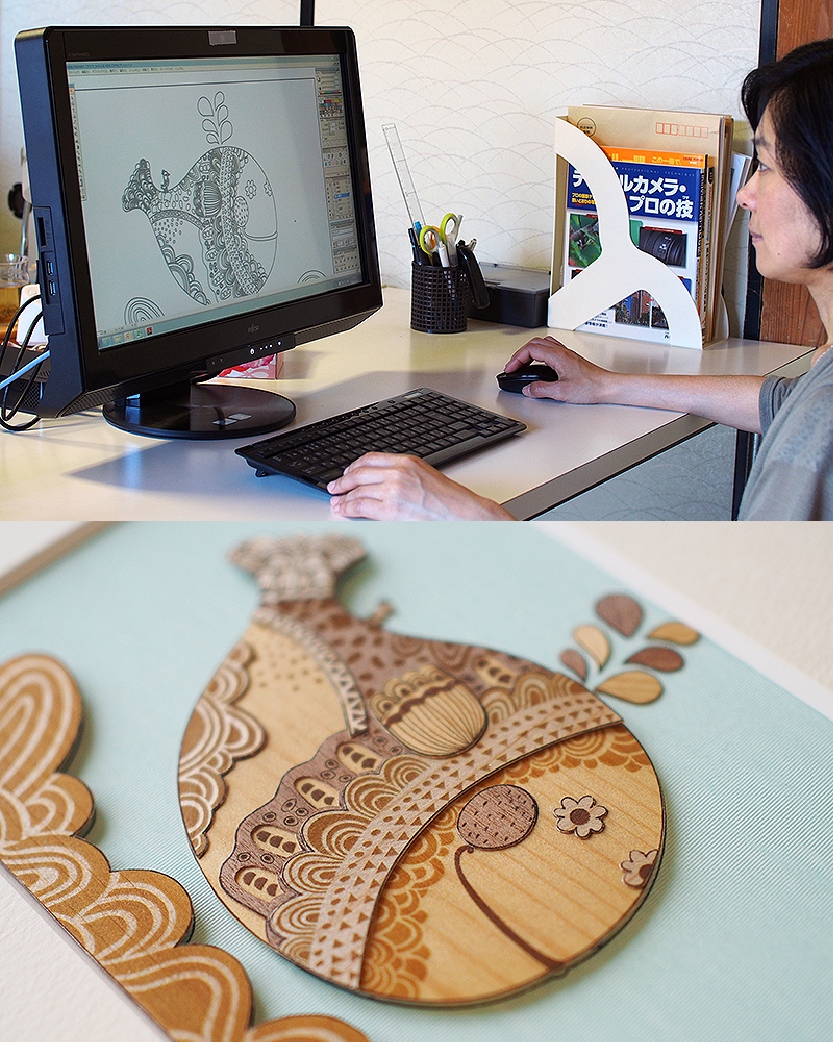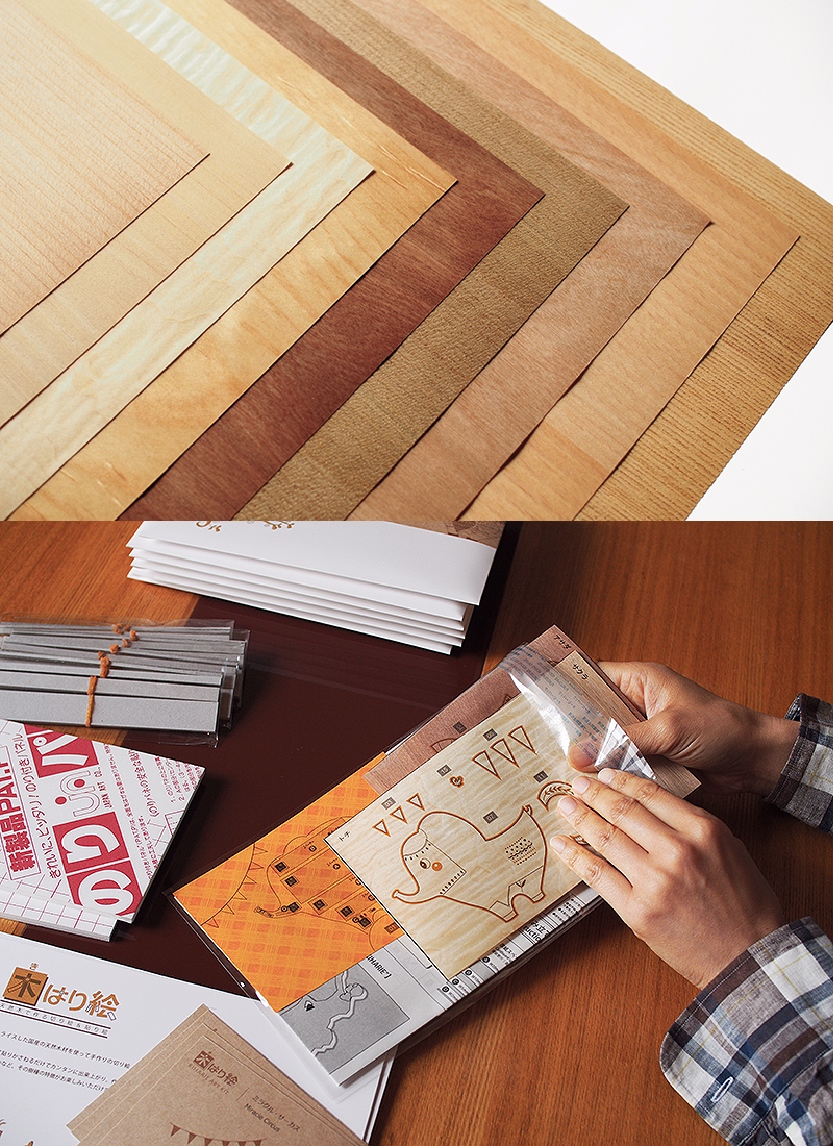
A story about the development and manufacture of KIHARIE
“Development edition”

■Key points of Design Work
The development of KIHARIE is largely a matter of design development. A balance has to be struck between the look of the finished work and the responsiveness of the handmade process.
The more detailed the cutting and pasting, the better the work will look, but the harder the work will be. Although a wood veneer can be handled like drawing paper, it is not the same as paper when it comes to detailed work.
Therefore, in KIHARIE, printing is also used to express details, but if there are too many printed parts, the print will look flimsy and lack three-dimensionality. On the other hand, if you reduce the number of printed parts and increase the number of handmade parts such as cutting and pasting, the difficulty of the work will take precedence and you will not feel the pleasure of making it.
The key is to find the right balance between the three-dimensionality of the finished product, the texture of the wood, the level of difficulty and the sense of achievement in making it.
■Selection of subject
The subject matter of designs varies, but there are two main types: illustrations and tracing from photographs or other sources.
Developing from illustrations often shows the individuality of the developer. Illustrations are often made by KINOWA staff (men), but since there are many women among KIHARIE users, the opinions of KINOWA employees (women) are strongly reflected in the illustrations. It’s truly said as “Better one cry of a crane than a thousand chirps from sparrows.” Sometimes we ask outside female illustrators to help us.
When tracing from photographs, the collection of materials is crucial. This is because the atmosphere of a landscape or a building will definitely change if the angle changes slightly. Also, when I trace, I sometimes get bogged down by details that are so fine that they cannot be seen no matter how much I enlarge the image. In fact, if it is that detailed, it is such a small part that it is almost invisible when made into a kit. But a day can end with a small part that is so small that it is almost invisible when it is made into a kit. This kind of development is also fun.
In both illustration and tracing, it is important to think about the cutting of the pieces and the order in which they are pasted. The parts that are on the bottom layer tend to be larger when pasted on top of each other, but if you make a part too large, it may be difficult to paste, or you may only be able to use one type of tree on that layer. When we design our products, we think about how we can create a more three-dimensional effect and how we can combine different types of trees so that customers can touch a lot of different trees.
■Development of original products
We are often asked by people from different industries if it is possible to develop original products. The conclusion is that it is possible, but depending on the theme, some are suitable for woodcarving and some are not. For example, because it is a method of layering parts by cutting them into pieces, it is not suitable for illustrations that do not have clear boundaries, such as watercolours, or illustrations that are flat and smooth, or illustrations that are too detailed in their depiction. If we were to use an oil painting analogy, Van Gogh would be possible, but Monet would be difficult. Development costs are charged separately, but we can also produce originals, so if you are interested, we will be happy to give you a quote.

“Manufacturing edition”

■veneer
The main material used for KIHARIE is called ‘veneer’, which is natural wood sliced into thin sheets. The wood is harvested in different regions of Japan and sliced into thin sheets using a special machine. The thickness of the veneer used in KIHARIE is 0.3 mm, about as thin as drawing paper. When the wood is felled, it is sliced fresh, not dried. It is like wood sashimi. The sliced wood is so thin that it could easily crack if left alone, so it is reinforced with Japanese paper on the back. This creates a craft material that will not crack or split when worked with scissors or cutters.
This veneer has been used as a surface and interior material for furniture. When veneer is applied over plywood, which warps and deforms little, it looks like solid wood, so it has been valued as a cost-saving and age-resistant material. In recent years, however, the number of factories producing these wood products and materials in Japan has declined due to the decline of traditional industries. In KINOWA’s hometown of Aizu, there used to be many woodworkers, such as Yama-shi (people who buy and cut down forests), Kijiji-shi (craftsmen who turn a wheel to make bowls, trays and other wooden objects) and Nuri-shi (craftsmen who apply lacquer to the wood), but now there are very few. Unfortunately, the veneer used in KINOWA comes from a large production centre outside the prefecture, but what will happen in the future?
There are many natural forests around KINOWA (bears are also a frequent visitor). Due to historical reasons such as the Boshin War, most of these forests are government owned. Some maintenance is being done, but it is not enough due to the lack of forestry workers. A small part of KINOWA’s profits is donated to forest conservation activities. The amount of material consumed by KINOWA is really small, so it does not contribute much to consumption, but we hope that local timber and the industries that use it will be revitalised.
Some of KINOWA’s handmade kits use coloured paper for the background in some designs, but the basic material used is veneer. We produce these kits every day, imagining the customers who will enjoy them.
■Towards more customers
From the very beginning, KINOWA has manufactured its products with the expectation that they will be enjoyed by customers in Japan as well as overseas. For this reason, the packaging and instructions are written in three languages (Japanese, English and traditional Chinese). Most of the instructions are illustrated so that they can be understood in countries other than these three languages.
For those who like the design but find it too difficult to make by hand, we also sell other products. Straps, games and other miscellaneous items are only available from the KINOWA online shop, as we make them in our limited spare time.
